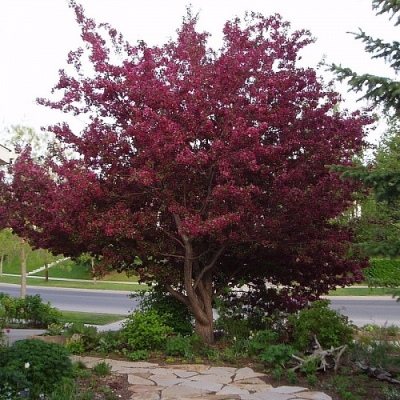
- Authors: Poland
- Appointment: fresh
- Appeared when crossing: Cardone x Arthur Turner
- Name synonyms: Ola
- Decorative: Yes
- Height: 5-6 m
- Crown: openwork, rounded in shape, spreading
- Escapes: young shoots are purplish brown, darken with age
- Flowers: delicate, dark pink
- Growth type : medium-sized
Sometimes apple trees are grown not only for the sake of harvesting, but also as a decoration for a garden, alley, courtyard, personal plot, park area. As a rule, these are decorative varieties that quickly adapt to climatic characteristics and soil. One of these is the Ola apple variety, which came to us from Poland.
Breeding history of the variety
The ornamental apple tree with the beautiful name Ola appeared thanks to Polish breeders, whose goal was to create an ornamental fruit culture that is widely used in landscape design. To breed the species, two varieties were crossed - Cardon and Arthur Turner.
Description of the variety
The Ola apple tree is a decorative medium-sized tree, reaching a height of 5-6 meters, with an openwork rounded crown. The spreading of the crown of an adult tree can reach 5 meters. The annual growth of tree shoots is 25-35 cm. The peculiarity of the tree is the leaves, which change color several times during the season - from light brown to juicy green. In terms of beauty and richness of aroma, the Ola apple tree is not inferior to the Japanese sakura.
Features, pros and cons
This ornamental fruit apple species is characterized by some features, thanks to which it is popular among gardeners, summer residents and designers: unpretentious care, visual appeal, edibility of fruits, frost resistance. In addition, the Ola apple tree is an excellent pollinator, so it just needs to be planted next to fruit trees to attract insects. The disadvantages of this species have not yet been found.
Ripening and fruiting
Apple blossoms begin in late spring (end of May) and lasts for several weeks. During this period, the tree is covered with lush, deep pink flowers, forming an openwork. The aroma is incredibly bright, sweet and persistent. Fruiting begins at the end of August and lasts until the first frost. At this time, the tree turns crimson red and continues to decorate the site or garden. Abundant flowering and fruiting is observed in the second year of tree growth.
Growing regions
Due to its frost resistance and quick adaptation to climatic conditions, an ornamental apple tree can be grown in almost any region of Russia, Ukraine, Belarus.
Yield
Yields are average because the crop is decorative.
Fruits and their taste
The apples by the tree are edible. They are characterized by small size - up to 3 cm in diameter, regular shape and unusual taste. Apples have a dark red color, hard skin, moderate juiciness. They taste sweet and sour with a pronounced astringency, which not everyone likes. Despite the decorative effect, the fruits can be eaten fresh, and also used for making jam, jam, compote.

Growing features
For planting an ornamental fruit crop, you need to prepare the soil - clear of weeds, dig up, moisten and saturate with fertilizers. The site should be well lit by the sun or in partial shade. The tree is resistant to winds. For planting, a fertile soil with neutral acidity is suitable, which breathes well and does not contain groundwater. Planting trees can be done in early spring and autumn.



Pollination
This apple species is self-fertile, so it is not necessary to plant pollinating apple trees nearby.
Top dressing
Top dressing of the culture must be carried out from the third year of tree growth. Mineral and organic fertilizers are required three times a year. In autumn, the near-stem zone is carefully dug up and potash and phosphorus substances are introduced. Organic matter is applied in early spring, before the buds bloom.

Frost resistance
The culture has good winter hardiness (-25 ... 29 degrees). It is recommended to insulate only a young tree. This requires sawdust, peat, straw or pine needles. The trunk and root system are insulated with burlap or agrofibre.

Diseases and pests
The apple tree has good immunity to diseases, fungal infections and pests, but occasionally the tree is exposed to scab, powdery mildew, rust and black crayfish. Spraying with insecticides will help get rid of diseases.

The apple tree is a popular fruit crop among gardeners. It can be found in many summer cottages. But at the same time, such trees are often affected by various diseases. It is very important to recognize the disease in time and carry out the necessary procedures for a speedy recovery. Otherwise, the fruits will be spoiled, and the tree itself may die altogether.

Review overview
The decorative Ola apple tree can often be found in alleys, in parks, in summer cottages and household plots. It is regularly used in the design decoration of the territory, the construction of a hedge. Most summer residents and gardeners note the absolute unpretentiousness of the variety, the incredible beauty during flowering and fruiting, as well as the unusual taste of the fruits, which are not so small against the background of other decorative apples.











































































